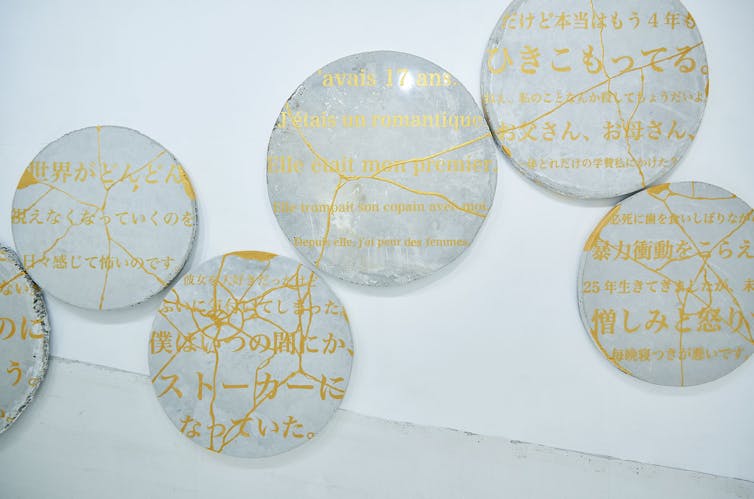Black Frost?
It was in September 1974 in NW Iowa and north we had a black frost. Killed every thing. Think around Sept third. Fifty years ago.
hikikomori
Hikikomori artists – how Japan’s extreme recluses find creativity and self-discovery in isolation
The Japanese word “hikikomori” translates to “pulling inwards”. The term was coined in 1998 by Japanese psychiatrist Professor Tamaki Saito to describe a burgeoning social phenomenon among young people who, feeling the extreme pressures to succeed in their school, work and social lives and fearing failure, decided to withdraw from society. At the time, it was estimated that around a million people were choosing to not leave their homes or interact with others for at least six months, some for years. It is now estimated that around 1.2% of Japan’s population are hikikomori.
When this trend was identified in the mid-90s, it was used to describe young, male recluses. However, research has shown that there is an increasing number of middle-aged hikikomori. In addition, many female hikikomori are not acknowledged because women are expected to adopt domestic roles and their withdrawal from society can go unnoticed.
Japanese manga researchers Ulrich Heinze and Penelope Thomas explain that, in recent years, there has been a subtle change in how people understand the phenomena of hikikomori. This shift is manifested through increased awareness of the complexity of the hikikomori experience within the mainstream media and acknowledgement of social pressures that can lead to social withdrawal. They suggest that the refusal to conform to social “norms” (such as career progression, marriage and parenthood) can be understood as a radical act of introversion and self-discovery.
In line with this image change, some hikikomori have rich creative lives and this can sustain vital human connection. Many people are now living in compulsory isolation because of COVID-19. While this is not the same as being hikikomori, we can learn from the different different ways in which these people have navigated through, or are still navigating through, experiences of isolation.
Don’t let yourself be misled. Understand issues with help from experts
Beautiful scars
Ex-hikikomori artist Atsushi Watanabe explains that his three-year isolation began through “multiple stages of withdrawal from human relationships, which resulted in feeling completely isolated”. At one point, he remained in bed for over seven months. It wasn’t until he began to see the negative impact that his withdrawal was having on his mother, that he was able to leave his room and reconnect with the world.
Tell me your emotional scars is an ongoing creative project by Watanabe. In this project, people can submit anonymous messages on a website, sharing experiences of emotional pain. Watanabe renders the messages into concrete plates, which he then breaks and puts back together again using the traditional Japanese art of kintsugi.
Kinstugi involves the joining of broken ceramics using a lacquer mixed with powdered gold. It is also a philosophy that stresses the art of resilience. The breakage is not the end of the object or something to be hidden, but a thing to be celebrated as part of the object’s history.

Tell me your emotional scars can be understood as a sublimation of this emotional pain – conveying negative, asocial feelings through a process that is socially acceptable, positive and beautiful. These works are a testament to suffering, but one that celebrates the possibility of healing and transformation.
For Watanabe, becoming hikikomori is often a manifestation of emotional scars, and he wants to create alternative ways of understanding unresolved past experiences. Watanabe asks us to “listen to the shaky voices that cannot usually be heard”. Listening to, and sharing experiences of hardship and even pain is one way to address the rise in loneliness that has resulted from the COVID-19 pandemic.
Fighting for privacy
Artist Nito Souji became a hikikomori because he wanted to spend his time doing “only things that are worthwhile”. Souji has spent ten years in isolation developing his creative practice, leading to a video game that explores the hikikomori experience.
The trailer for the video game Pull Stay opens with a scene in which three people break into the home of a hikikomori. The player must fights off intruders as the hikikomori’s robot alter-ego by, for example, frying them in tempura batter or firing water melons at them.
The aim of Pull Stay is to protect the home and seclusion of the hikikomori character. In doing so, the player begins to embody a visceral need for privacy. Pull Stay is testament to the creative outcomes that can come from carving out a profound sense of “headspace”. Souji explains his creative process as, “having hope and making a little progress every day. That worked for me”.
Despite choosing to withdraw from society, sustaining hope and indirect connection through creative practice has helped artists such as Souji use this time for self-development. His aim is, and always has been, to be able to reenter society, but on his own terms.
Well-known Japanese entrepreneur Kazumi Ieiri, himself a recovered recluse, describes the hikikomori experience as “a situation where the knot is untied between you and society”. But he continues, there is no need to hurry to retie social bonds, rather to “tie small knots, little by little”.
The process of returning to “normal life” might be gradual for many of us, but creative expression could be a powerful way of to both share experiences of isolation and to reconnect with others within and beyond lockdown.
Author
-
 Jessica Holtaway
Jessica Holtaway
Lecturer in Visual Communication, Solent University
Disclosure statement
Jessica Holtaway does not work for, consult, own shares in or receive funding from any company or organization that would benefit from this article, and has disclosed no relevant affiliations beyond their academic appointment.
Partners
Languages
- Bahasa Indonesia
- English
 We believe in the free flow of information
We believe in the free flow of information
Republish our articles for free, online or in print, under a Creative Commons license.
Resisting The Global Land Grab
very smart people figured it out... pay attention
👇
sign up: https://thenaturalhistorymuseum.org/video-highlights-resisting-the-global-land-grab/
How Those Using "Useful Idiots" Become "Useful Idiots" | how totalitarian movements come to power
From the brilliant Charles Hugh Smith: https://charleshughsmith.blogspot.com/2024/07/how-those-using-useful-idiots-become.html
How Those Using "Useful Idiots" Become "Useful Idiots"
And that's how totalitarian movements come to power: the citizens
give up on the Establishment factions, as they've failed to solve the
problems being exploited by extremist groups.
Useful Idiots describes those who support or encourage
movements of mayhem in the misguided belief that these movements are
positive or necessary. The classic example (and no, V. Lenin did not
coin the phrase) are Western fellow-travelers who supported the
totalitarian Soviet regime out of naivete, idealism or sentimentality.
But there is another class of Useful Idiots: when powerful
factions are jockeying for supremacy in societies riven by chronic
crisis (economic stagnation, social discord, etc.), some of these groups
may cynically see extremist movements as Useful Idiots who can be directed to further the interests of the cynical group.
This is one of the implicit themes in the German TV series Babylon Berlin, a lavish, intricately plotted drama set in Berlin in the years before the Nazi rise to power in 1933. Netflix hosted the first three seasons for several years but gave it up a few years ago. The entire four seasons (season 4 was released in the US this year) are available on MHZ Choice, which serves up a wide range of European TV programming with subtitles.
Various factions are battling for influence in the wretched stew of poverty, political turmoil and postwar trauma of 1920s Berlin: there's the Communists, suitably ruthless; the gangsters running the seamy, thriving Berlin Underworld, also ruthless but in a more calculated, nuanced fashion; the Militarists, who seek to restore the Monarchy and Germany's military might by dispensing with Germany's troubled experiment with democracy, and the nascent Nazis, represented by the SA Brown Shirts street thugs loyal to the ideals of the Nazi party who organize street mobs to beat up their enemies: Communists and Jewish shopkeepers.
Lastly, there are the embattled police, trying to keep order and treat every miscreant fairly under the law, and the government of the Republic, trying to maintain a weak, debt-burdened democratic state against the forces trying to tear it down.
The Monarchist / Militarist Industrialists view the Brown Shirts as Useful Idiots who helpfully weaken the Communists and labor unions threatening their profits and political power. The Nazis also generate a general sense of uncertainty and chaos which the Militarists intend to use for their own purposes: the more dire the economic and social situation becomes, the greater the appeal of a restored monarchy and a powerful military to "restore order."
Unlike the characters in Babylon Berlin, we know how the struggle ends: it's the Militarist Industrialists who were the Useful Idiots of the Nazis, not the other way around. This is how those trying to use Useful Idiots for their own purposes end up being the Useful Idiots of those fomenting extremism.
We can discern the dynamic underlying this reversal. Once extremism is normalized, extreme polarization is also normalized, and those Establishment factions who started out seeking to position themselves as the restorers of order and prosperity are increasingly viewed as no longer up to the task: stronger medicine is now needed to restore order and right the sinking ship of state.
The extremists who were once small thorns in the side of the Establishment are now viewed as the only groups capable of doing "whatever it takes" to end the chaotic decline of civic order and the economy.
The citizens' loyalty to the Establishment factions is weak, while the fervent True Believers in the extremist camps are completely committed to the righteousness of their cause: only we can save the nation.
And that's how totalitarian movements come to power: the citizens give up on the Establishment factions, as they've failed to solve the problems being exploited by extremist groups.
Note to those currently in power: be careful about who you're encouraging as Useful Idiots: you might end up being the Useful Idiots in the endgame.

Play it as it lays, but play it carefully. Overconfidence and hubris can lead us into becoming unknowing Useful Idiots.



oh yeah...


-
Dean Henderson and Jeff discuss current events and take a whack at the global oligarchy. Check out more info from Jeff Rense at Alt News ...
-
Burt Bacharach, Music artist Co-author (with lyricist Hal David) of an extensive string of hits in the '60s, Burt Bacharach is one of...





